Pint-Size Book Authors: Using Early Readers as Mentor Texts
Children love to write books. In the classroom, when they read and see books all around them, they are naturally inspired to create. It's as though there is magnetism pulling them toward paper and pencil. Add colored markers or crayons and a simple invitation to them to make up stories, and they are off and running.
In my 26 years as a teacher/educator, my best advice is to nourish this intuitive reading-writing connection is by keeping the experiences playful. Take your cues from students’ enthusiasm in specific topics and books and their developmental readiness. Flood the classroom with wordless books, beloved read alouds, decodable texts, and student-created books so you have a wide range of books to read aloud, use in shared reading, and tuck into book baggies for children to take home (Taberski, 2017). Writing will happen in tandem with reading because children from birth are connecting spoken and written language. They watch adults constantly to learn their world, and before too long they begin to get that those squiggly symbols on the page are related to the meaningful messages they hear through speech and story books.
Reading, Writing, Talking
Reading and writing are similar in many ways, and it’s the reciprocity between the two processes that makes for joyful teaching of both. As C.C. Bates writes in her book Interactive Writing, “when children connect these two pools of knowledge, their literacy processing system becomes the benefactor. (Clay, 2001; Bates, 2020). Bates shares that Maria Clay (2001) uses a car analogy to explain the importance of reciprocity. When driving, we use rearview and sideview mirrors. These mirrors, as any driver knows, are instrumental in the decisions made behind the wheel because they provide varying perspectives. Their individual fields of vision may be limited, but when used in tandem they allow a driver greater clarity. The same is true for writing and reading.
It is important to remember that children develop as writers and readers simultaneously--not one after the other. It is for this reason that educator and early literacy expert Wiley Blevins ’recommends that meaningful reading and writing experiences take up at least 50% of daily phonics instruction (Blevins, 2020). In fact, all aspects of communication are interrelated to a child, from talking and listening to composing and reading. Children are just as ready to use writing to communicate thoughts and feelings as they are to express them orally--we teachers merely need to open that door. Let’s look now at how to open that door with the magic of books.
Reading in PreK, Kindergarten, First Grade
As you teach emergent readers and writers about concepts of print, the alphabetic principle, concepts of sentences, story structure, letter formation, high frequency words, and all the rest, it's important to intentionally read books that are accessible, engaging, and yet provide students with sufficient challenge. So, to create a print-rich environment we include everything from environmental print to well-read picture books. Yes, create a vast range of texts because children enter school with a vast range of readiness.
Some of the most engaging texts for students are found both in the library but also right under our noses out in the world. Children love maps of places such as zoos. They love the brochures you find in tourist centers. They love books that were written together as a class now turned into a book for everyone. So, it stands to reason that the stories and nonfiction students develop and illustrate will, to some extent, mirror the books and skills they are immersed in--- texts from My Bossy Sister Sahar to All About Worms. For the purpose of this blog, however, I’m going to focus on the power of using early readers as mentor texts.
What are Early Readers?
Early readers are books that emerging and new readers can access because their illustrations are appealing, many of the words are well known, and children, with little or no support, can read them on their own. Some classic early readers include the Bob Books, by Bobby Lynn Maslen or Splat the Cat books by Rob Scotten. More recently published early readers include It’s Shoe Time! by Bryan Collier and The Mo Books by David Adler.
How to Use These Books
Read these books aloud, use them for shared reading, put them in a learning center, and add them to the classroom library. Brand new readers love to hear books over and over again and then pick those books up themselves. The point to remember is that before kids put pen to paper, they must have a comfort level with a book, perhaps some letters and sounds, perhaps some of the words, and the concept of story. This gives them great confidence as they go into the hefty journey of creating their own books.
How to Support Composing
In the primary grades, we support writers’ development when our instruction—and student practice--includes an integration of pictures, print, and oral composition. Now, let me share a few of my favorite methods for using early readers to support early writers.
First, start with paper booklets that have a picture space and some space for lines. Staple a few pages together to make three-page booklets. Have single sheets available for students to add pages if they would like. Here’s an example from a first grader:
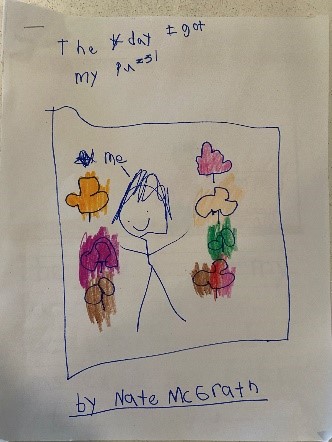
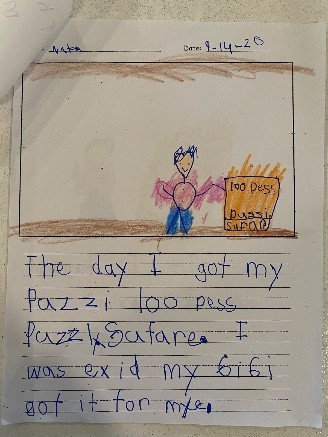
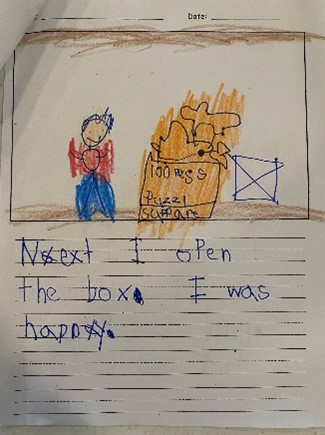
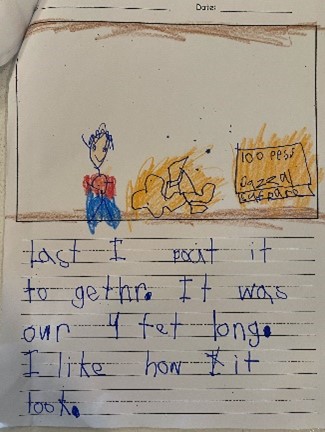
Once you have booklets on hand, let the students create with abandon! Support this playful experience with writing books by reminding students that they are authors along with all of the authors of the books in the classroom. Talk with each student, cheering them on, or if they seem stuck, ask questions that prompt them to orally rehearse their story. Honor story over correctness! At this age, we do not expect perfect spelling. Instead, we encourage invented spelling and the use of high frequency words. In fact, many young writers will be using a combination of sketching, letter-like symbols, and letter strings. This is important work for little ones. Thus, we expand the definition of writing to “making meaning for others.” Writing, then for our littlest ones, is a combination of attempts at pictures, print, and oral composition.
More Intentional Teaching Ideas
With this playful approach to writing in place, you can then begin to use books that happen to reinforce strategies and skills you notice kids need additional practice with-- or are ready to try. No matter what, use only those texts that begin to bring in your beloved early readers students have heard before and may even know by heart.
In minilessons, teach strategies to students for rereading the books with an eye to borrowing specific techniques, or anything at all. Here are a few things you can teach:
Create a collection
Take a book with a character and create other stories with those characters. For instance, In the A-Z for Mat Man and Me series, you may choose to use Nell and the Nest. In this sweet story, Nell finds a nest and then goes to show her Nana. Student writers can decide to have another adventure with Nell, Nana, and the nest. To prepare for writing, talk about different possible stories and then ask students to choose one to create in their booklets. Maybe Nell and Nana notice that the nest has new little ones. Or Nell and Nana see another nest. Whatever ideas that come to students, they can refer back to the book for inspiration. If there are copies of the books available for students, they can refer to it to accurately write some sight words.
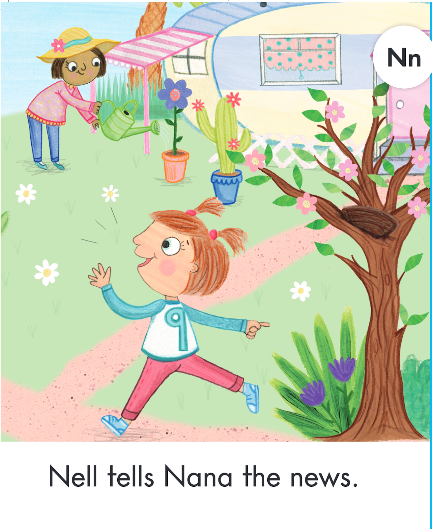
Curate sentence stems
When looking back at a well-read book, choose a few of the sentence stems that lend themselves to creating pattern books. Pattern books are those that use the same or similar sentence frames repeatedly throughout the story. For example, in Bill Martin, Jr. and Eric Carle’s Brown Bear, Brown Bear, the pattern of Name, Name, what do you see? I see_____________ looking at me. With those sentence stems, young writers can write Mommy, Mommy what do you see? I see Jack looking at me.
To begin, practice using sentence stems from books in interactive writing. Once student writers know these stems a bit better, keep them displayed in case students want to use them in their books. Note of caution: it is best not to require stems Rather, have a few stems at the ready for students to naturally use as they see fit.
Students might even begin to write pattern books that use these stems.Following are some stems you might teach with from Rex and the Rake
What is _____?
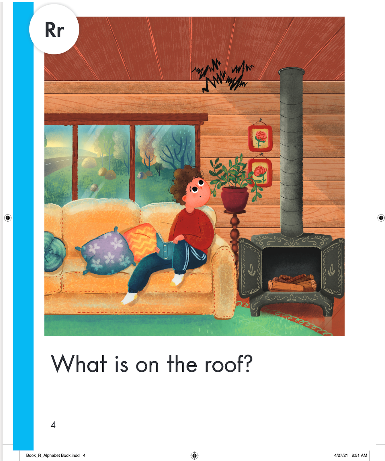
Will the ____?
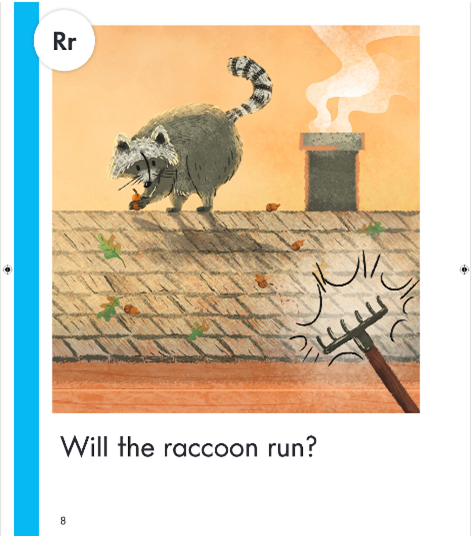
Now the _____?
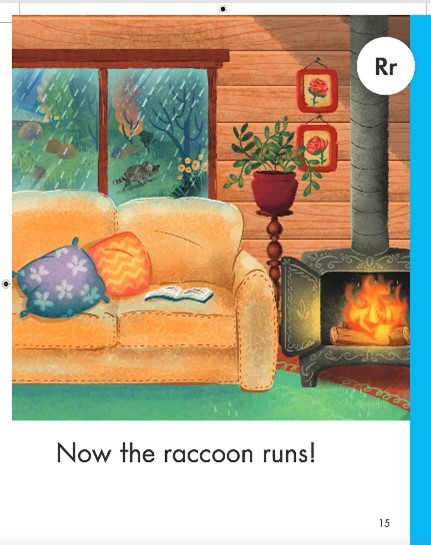
Match Sketches to Words to Make Meaning
One of the best ways for our littlest learners to write is to begin with sketches. In fact, I love to teach students how to use sketching to plan. This means that students take a booklet and sketch one part of their story on each page. Page one includes what happens first, page two includes what happens next, and the third page includes what happened after that. Once the students sketch across the pages, they come back and write words to match the sketches. Shown here is a sample of a booklet that began with sketches and the kindergartener added words to it.
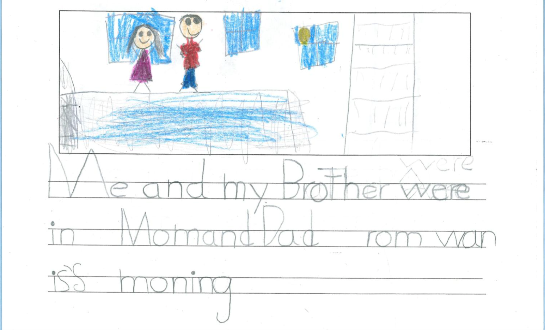
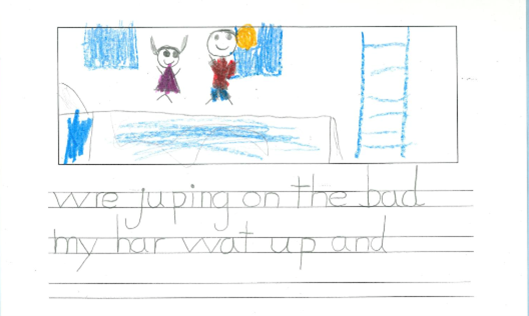
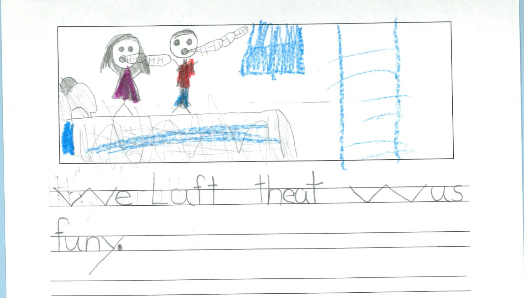
This approach has mountains of benefits for kids. It teaches and reinforces organization and sequencing. It provides students with a method for planning their writing. It acts as a natural graphic organizer, so students do not need anything more than a booklet with space for sketches and words. And when students write to match the sketch there is space naturally built in for revision. So, when students go back to revise, they have space to add another sentence or two to their book.
Use any favorite early reader or the A-Z with Mat Man and Me books to point out the way authors match their words to sketches. Take one of your favorite Student Letter Books that has been well read. Show students that what is happening in the picture is also showing up in the words. Do this with many pages and many beloved books.
Model Revision Using Books and Sticky Notes
It is also fun to show how to revise by using a beloved book. This helps children realize that writing is a form of revision. For example, students can Add dialogue or thinking using sticky notes and then bring that down into that.
Try using an early reader or an A-Z for Mat Man and Me book. This instruction might sound like:
Today we are going to use one page of our book to practice revising. We are going to add the thoughts or words of the characters and add them to a sticky note. Let’s look at Gabby and Gus on this page. Imagine what they are thinking or saying. Share with a partner.
As students share with one another, jot down some of the words they are suggesting as a revision. Add those words to a sticky note and put them on the page. Voila! You have just practiced a revision technique together.
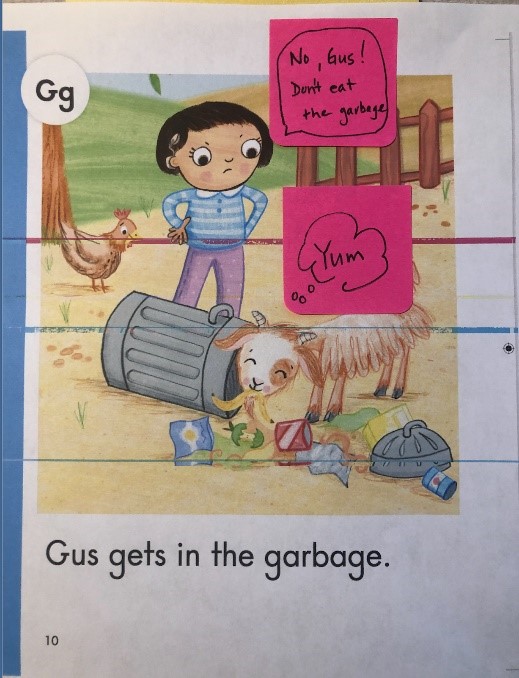
These are just a few ways to use early readers as mentor texts for writing. I invite you to let your educator imagination soar as you discover your own new pathways to develop readers through writing and writers through reading.